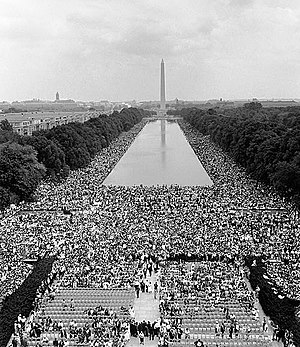| March on Washington | |
|---|---|
| Part of the Civil Rights Movement | |
 | |
| Date | Template:Aug 28, 1963 |
| Location | Washington, D.C., U.S. 38°53′21″N 77°3′0″W / 38.88917°N 77.05000°W |
| Caused by |
|
| Resulted in |
|
The March on Washington for Jobs and Freedom, also known as simply the March on Washington or the Great March on Washington,[1][2] was held in Washington, D.C., on August 28, 1963.[3] The purpose of the march was to advocate for the civil and economic rights of African Americans. At the march, final speaker Dr. Martin Luther King Jr., standing in front of the Lincoln Memorial, delivered his historic "I Have a Dream" speech in which he called for an end to racism and racial segregation.[4]
The march was organized by Bayard Rustin and A. Philip Randolph, who built an alliance of civil rights, labor, and religious organizations[5] that came together under the banner of "jobs and freedom."[6] Estimates of the number of participants varied from 200,000 to 300,000,[7] but the most widely cited estimate is 250,000 people.[8] Observers estimated that 75–80% of the marchers were black.[9] The march was one of the largest political rallies for human rights in United States history.[6] Walter Reuther, president of the United Auto Workers, was the most integral and highest-ranking white organizer of the march.[10][11]
The march is credited with helping to pass the Civil Rights Act of 1964.[12][13] It preceded the Selma Voting Rights Movement, when national media coverage contributed to passage of the Voting Rights Act of 1965 that same year.[14]
- ^ Ward, Brian (April 1998). "Recording the Dream". History Today. Archived from the original on June 28, 2011. Retrieved September 4, 2017.
Yet by the end of the year the company was promoting its Great March to Washington album, featuring 'I Have A Dream' in its entirety.
- ^ King III, Martin Luther (August 25, 2010). "Still striving for MLK's dream in the 21st century". The Washington Post. Washington, DC. ISSN 0190-8286. Retrieved May 21, 2013.
- ^ "March on Washington". History. Retrieved January 23, 2021.
- ^ Suarez, Ray (August 28, 2003). "The March on Washington Remembered". PBS NewsHour. Public Broadcasting Service. Retrieved May 21, 2013.
- ^ Cite error: The named reference
Veteranswas invoked but never defined (see the help page). - ^ a b Bayard Rustin Papers (August 28, 1963), March on Washington (Program), National Archives and Records Administration, retrieved May 21, 2013
- ^ Cite error: The named reference
WDLwas invoked but never defined (see the help page). - ^ Hansen, D. D. (2003). The Dream: Martin Luther King, Jr., and the Speech that Inspired a Nation. New York: Harper Collins. p. 177. [ISBN missing]
- ^ "50th Anniversary of the 1963 March on Washington for Jobs and Freedom Panel Discussion at the Black Archives of Mid-America". The U.S. National Archives and Records Administration. August 7, 2013. Archived from the original (press release) on October 4, 2015. Retrieved August 1, 2017.
- ^ Euchner, Charles (2010). Nobody Turn Me Around: A People's History of the 1963 March on Washington. Beacon Press. ISBN 978-0-8070-9552-2.
- ^ "American Educator". American Federation of Teachers. Fall 2013. p. 35. Retrieved May 27, 2020.
- ^ Dubrin, Doug. "The March on Washington and Its Impact". www.pbs.org. Archived from the original on January 9, 2013. Retrieved August 29, 2020.
- ^ Jenkins, Alan (August 28, 2013). "An important goal of the 1963 March on Washington remains unfulfilled". The Hill. Retrieved August 29, 2020.
- ^ Weinstein, Allen (2002). The Story of America: Freedom and Crisis from Settlement to Superpower. DK Publishing, Inc. ISBN 978-0789489036.